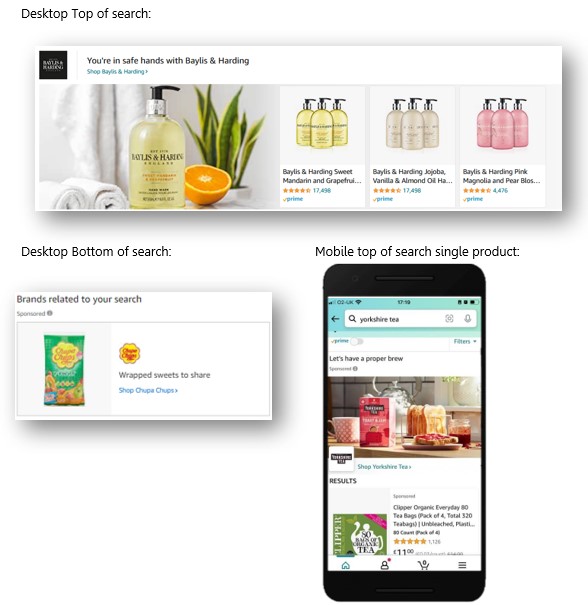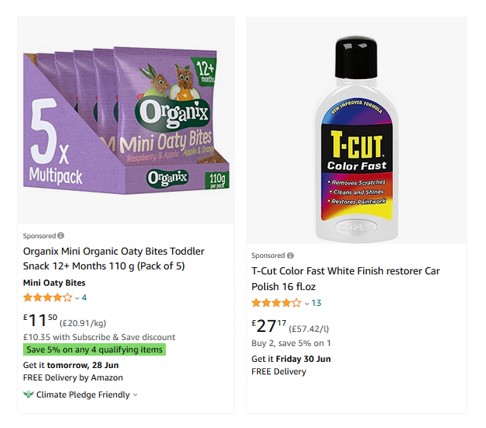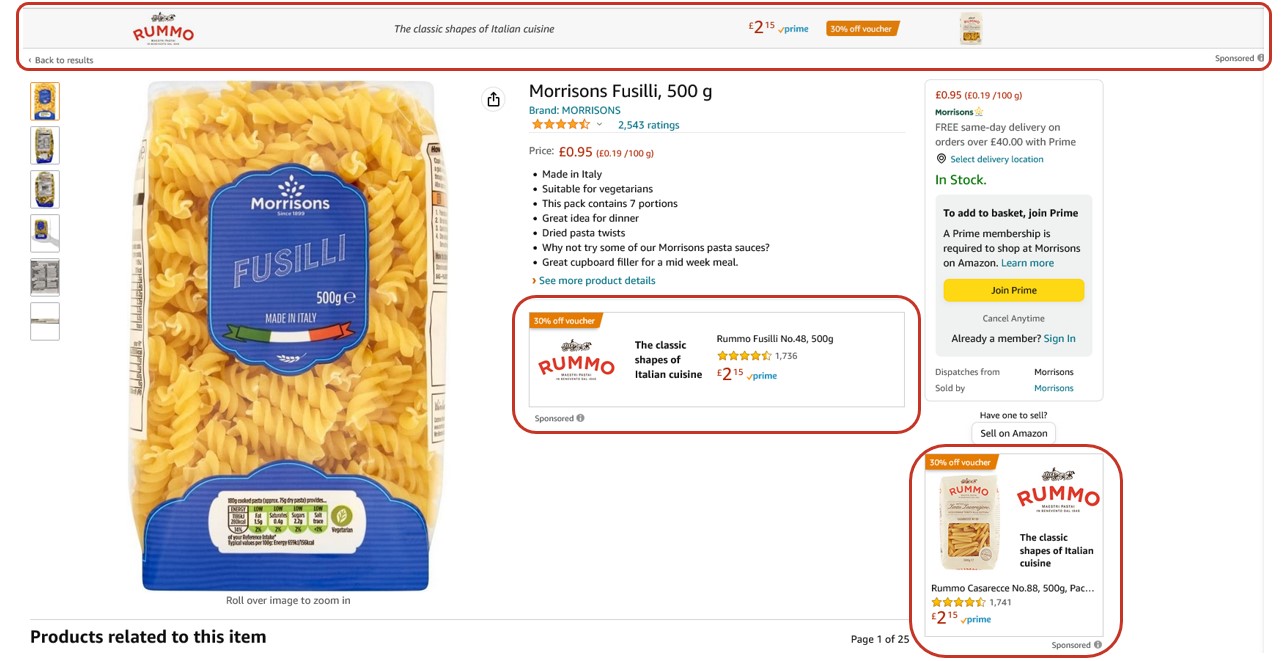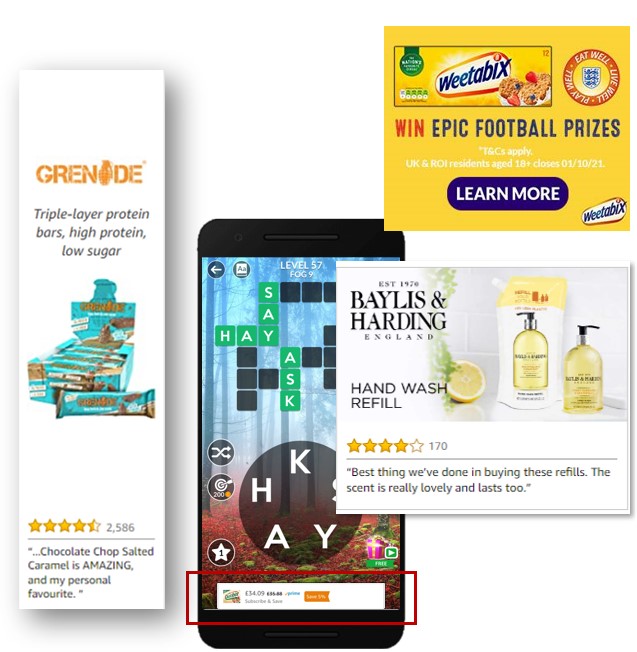With its two advertising platforms and multiple ad formats, Amazon advertising can be a confusing space. Here’s our quick guide to what’s what.
Sponsored ads
Sponsored Ads is Amazon’s self-service Pay Per Click (PPC) platform. The ads mainly appear on the Amazon websites and work best when presenting a product relevant to the shopper’s search. There are 3 ad types here:
- Sponsored Brands
- Sponsored Products
- Sponsored Display
Sponsored Brand

Sponsored Brand ads typically appear at the top of a search page, but they can also appear at the bottom of the page, or on product detail pages. They take different forms depending on the device you are using, the number of products you associate with the ad and how you are directing the traffic (to a product list or a brand store).
Sponsored Product

Sponsored Product ads appear in search results and on product detail pages. They are in priority placements and look exactly like other search results with the exception of the word ‘Sponsored’ above the listing. On detail pages, they are usually displayed in a carousel underneath the main listing.
Sponsored Display

Sponsored Display ads can appear in all sorts of places, from the thin strip at the top of the page, to a placement immediately underneath the product details. Their appearance varies accordingly. Although part of the Sponsored Ads suite, they are a slightly different form of Amazon advertising.
The targeting for Sponsored Product and Sponsored Brand ads is either by specific customer searches, or specific products/categories. So the ads display underneath a specific search or when viewing a particular product. Sponsored Display ads can work in a similar way to the Sponsored Product and Sponsored Brand product targeting ads, or they can do something a bit different! With this ad type you can target audiences (people) ie rather than showing an ad based on what the shopper has just searched for, it can serve an ad based on what that shopper bought or looked at last week or last month. The Sponsored Display ads can also serve either on or off Amazon. You can even choose to pay for them based on the number of impressions rather than the number of clicks. In this way, Sponsored Display ads are a little bit like DSP ads (see below).
Many sellers operate their own Sponsored Ads account, and it isn’t difficult to do this. However, if you have significant ad budgets to play with then you might need a more structured approach to maximising your return on investment. At MinsterFB, we provide a full service including commercial, inbound, listings, brand stores and more, or none at all. If you are looking for ads-only support there are many agencies available that will be happy to talk to you.
DSP ads
DSP is a completely different form of Amazon advertising. This type is highly sophisticated and is not available on a self serve basis. You will need to work with a specialist agency or directly with Amazon to use this type of Amazon advertising. However, to work directly with Amazon you will need a budget of at least £100k for each campaign.
The Amazon DSP is a Demand Side Platform, a system that matches ad inventory with audience targeting for advertisers.
Key difference #1 – Targeting
The targeting for DSP is not current behaviour (eg searching for products/viewing a product detail page), but the shoppers themselves. You can reach shoppers based on a geographic target, whether they shop regularly for kids items, the type of car they own or the things that they have been searching for last week or last month. In addition, you can intersect these audiences and even show them different creatives. So you can target Welsh Rugby team merchandise ads to shoppers who have bought rugby merchandise on Amazon in the last year and who live in Wales. Or you can target people who have viewed products in your chosen category recently but who haven’t yet purchased. Or those who have purchased competitor products but not your own brand.
Key Difference #2 – Where the ad is shown
You may choose to show your Amazon DSP ads on Amazon itself (or other platforms owned by Amazon, such as Twitch or IMDB). However, you can also choose to display the ads outside of the Amazon world. These ads use the same sophisticated targeting but you can place them on news websites, gaming apps or other sites according to your aim. Or you can pick all the options and let the automated optimisations make sure that the system chooses the most relevant placements for your audience.
Key Difference #3 – Creative

DSP creative can follow a similar templated form to the Sponsored Ads creative shown above. These creatives look like the examples on the LHS and on the mobile image left. They pull product images from your Amazon listing together with other information such as price, review count and review quotes. This can be the surest shortcut to a quick conversion. However you can also treat your DSP creative as a blank canvas and do something different as in the Weetabix example above, or you can create a hybrid, where you control the (more interesting) image, but the price or other product details pull directly from your product listing.
Difference #4 – How the ads are bought
With DSP, the ads are bought on a CPM, or cost per thousand impressions basis. This means that Click Through Rate is more important than it is for the majority of the Sponsored Ads, where you only pay for a click and the impressions are effectively “free”. However, this also means that sales are attributed to views and not only clicks. If someone views your ad but doesn’t click on it, and then goes on to make a purchase, that purchase will still show up in your ad attributed sales data.
In summary, there are two very different ad platforms available via Amazon. Your choice will depend on a number of factors, but most vendors and sellers will begin with the Sponsored Ads. After they have learned what is and isn’t possible there, they decide whether they are ready for the DSP platform.
At MinsterFB we are proud to have DSP access and expertise. We are happy to advise our clients on the best route for them on either or both platforms.